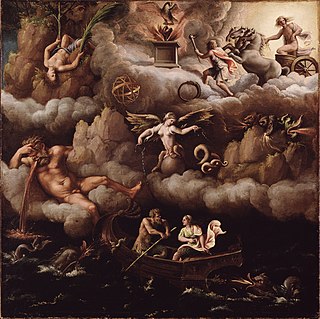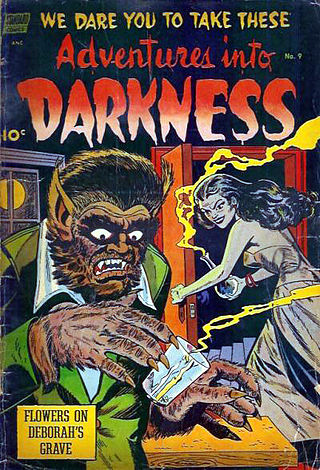
Hyenas, or hyaenas, are feliform carnivoran mammals belonging to the family Hyaenidae. With just four extant species, it is the fifth-smallest family in the Carnivora and one of the smallest in the class Mammalia. Despite their low diversity, hyenas are unique and vital components of most African ecosystems.

A vampire is a mythical creature that subsists by feeding on the vital essence of the living. In European folklore, vampires are undead creatures that often visited loved ones and caused mischief or deaths in the neighbourhoods which they inhabited while they were alive. They wore shrouds and were often described as bloated and of ruddy or dark countenance, markedly different from today's gaunt, pale vampire which dates from the early 19th century. Vampiric entities have been recorded in cultures around the world; the term vampire was popularized in Western Europe after reports of an 18th-century mass hysteria of a pre-existing folk belief in Southeastern and Eastern Europe that in some cases resulted in corpses being staked and people being accused of vampirism. Local variants in Southeastern Europe were also known by different names, such as shtriga in Albania, vrykolakas in Greece and strigoi in Romania.

In folklore, a werewolf, or occasionally lycanthrope is an individual who can shape-shift into a wolf, either purposely or after being placed under a curse or affliction, with the transformations occurring on the night of a full moon. Early sources for belief in this ability or affliction, called lycanthropy, are Petronius (27–66) and Gervase of Tilbury (1150–1228).

A monster is a type of fictional creature found in horror, fantasy, science fiction, folklore, mythology and religion. Monsters are very often depicted as dangerous and aggressive, with a strange or grotesque appearance that causes terror and fear, often in humans. Monsters usually resemble bizarre, deformed, otherworldly and/or mutated animals or entirely unique creatures of varying sizes, but may also take a human form, such as mutants, ghosts, spirits, zombies, or cannibals, among other things. They may or may not have supernatural powers, but are usually capable of killing or causing some form of destruction, threatening the social or moral order of the human world in the process.

Werewolf fiction denotes the portrayal of werewolves and other shapeshifting therianthropes, in the media of literature, drama, film, games and music. Werewolf literature includes folklore, legend, saga, fairy tales, Gothic and horror fiction, fantasy fiction and poetry. Such stories may be supernatural, symbolic or allegorical. A classic cinematic example of the theme is The Wolf Man (1941) which in later films joins with the Frankenstein Monster and Count Dracula as one of the three famous icons of modern day horror. However, werewolf fiction is an exceptionally diverse genre, with ancient folkloric roots and manifold modern re-interpretations.

The striped hyena is a species of hyena native to North and East Africa, the Middle East, the Caucasus, Central Asia, and the Indian subcontinent. It is the only extant species in the genus Hyaena. It is listed by the IUCN as near-threatened, as the global population is estimated to be under 10,000 mature individuals which continues to experience deliberate and incidental persecution along with a decrease in its prey base such that it may come close to meeting a continuing decline of 10% over the next three generations.

A werecat is an analog to "werewolf" for a feline therianthropic creature.
Vrykolakas, also called vorvolakas or vourdoulakas, is a harmful, undead creature in Greek folklore. It shares similarities with numerous other legendary creatures, but is generally equated with the vampire of the folklore of the neighbouring Slavic countries. While the two are very similar, a vrykolakas eats flesh, particularly livers, rather than drinking blood, which combined with other factors such as its appearance bring it more in line with the modern concept of a zombie or ghoul.
Therianthropy is the mythological ability or affliction of individuals to metamorphose into animals or hybrids by means of shapeshifting. It is possible that cave drawings found at Cave of the Trois-Frères, in France, depict ancient beliefs in the concept.

The lightning bird or impundulu or thekwane is a creature in the folklore of the Zulu tribe.
A soucouyant, among other names, is a kind of shape-shifting, blood-sucking hag present in Caribbean folklore.

Colombian folklore are beliefs, customs and cultural traditions in Colombia.
Mythic humanoids are legendary, folkloric, or mythological creatures that are part human, or that resemble humans through appearance or character. Each culture has different mythical creatures that come from many different origins, and many of these creatures are humanoids. They are often able to talk and in many stories they guide the hero on their journey.

Legends of vampires have existed for millennia; cultures such as the Mesopotamians, Hebrews, ancient Greeks, and Romans had tales of demonic entities and blood-drinking spirits which are considered precursors to modern vampires. Despite the occurrence of vampire-like creatures in these ancient civilizations, the folklore for the entity known today as the vampire originates almost exclusively from early 18th-century Southeastern Europe, particularly Transylvania as verbal traditions of many ethnic groups of the region were recorded and published. In most cases, vampires are revenants of evil beings, suicide victims, or witches, but can also be created by a malevolent spirit possessing a corpse or a living person being bitten by a vampire themselves. Belief in such legends became so rife that in some areas it caused mass hysteria and even public executions of people believed to be vampires.
Buda, in Ethiopian and Eritrean folk religion, is the power of the evil eye and the ability to change into a hyena. Buda is generally believed by the wider society to be a power held and wielded by those in a different social group, for example among the Beta Israel or metalworkers. The belief is also present in Sudan, Tanzania, and among the Berber people in Morocco.

West African mythology is the body of myths of the people of West Africa. It consists of tales of various deities, beings, legendary creatures, heroes and folktales from various ethnic groups. Some of these myths traveled across the Atlantic during the period of the Trans-Atlantic slave trade to become part of Caribbean, Cuban and Brazilian mythology.

In mythology and literature, a werewoman or were-woman is a woman who has taken the form of an animal through a process of lycanthropy. The use of the word "were" refers to the ability to shape-shift but is, taken literally, a contradiction in terms since in Old English the word "wer" means man. This would mean it literally translates to "man-woman".

The spotted hyena has a long history of interaction with humanity; depictions of the species exist from the Upper Paleolithic period, with carvings and paintings from the Lascaux and Chauvet Caves. The species has a largely negative reputation in both Western culture and African folklore. In the former, the species is mostly regarded as ugly and cowardly, while in the latter, it is viewed as greedy, gluttonous, stupid, and foolish, yet powerful and potentially dangerous. The majority of Western perceptions on the species can be found in the writings of Aristotle and Pliny the Elder, though in relatively unjudgmental form. Explicit, negative judgments occur in the Physiologus, where the animal is depicted as a hermaphrodite and grave-robber. The IUCN's hyena specialist group identifies the spotted hyena's negative reputation as detrimental to the species' continued survival, both in captivity and the wild.
Superstition is highly prevalent in Ethiopia. Like Turkey and Greece, Ethiopian culture believes in the evil eye. In Ethiopia this belief helps uphold a caste system.

Spotted hyenas are widely distributed in Ethiopia specifically in the eastern parts like Harar and Somali Region. They also dwell in urban areas like Addis Ababa where they have been estimated at about a thousand and scavenge rubbish substances and feral dogs and cats. Scavenging on remains is a common feature of spotted hyenas that focus around waste material and also corpses.














